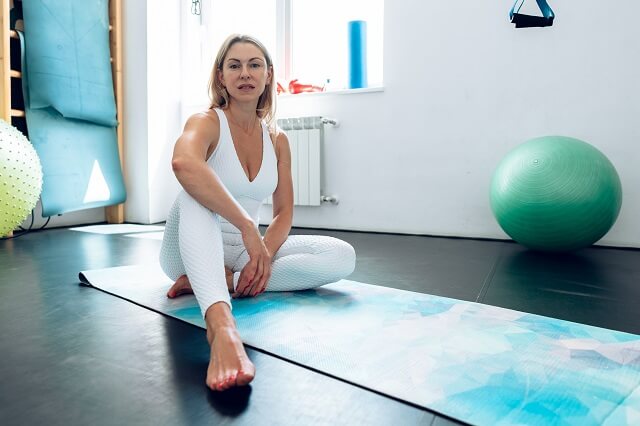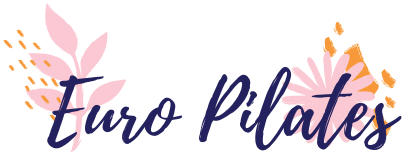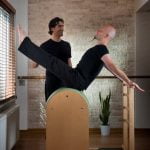La schiena è una parte del corpo estremamente importante che spesso viene trascurata. Spesso, le persone si concentrano sugli addominali o sulle gambe durante gli allenamenti, senza rendersi conto che una schiena sana è fondamentale per un benessere generale. Ecco perché i pilates possono giocare un ruolo cruciale nel mantenere una schiena in salute e forte.
Gli esercizi di pilates per la schiena lavorano sia sulla forza che sulla flessibilità dei muscoli dorsali, migliorando la postura e riducendo il rischio di lesioni. I muscoli dorsali sono fondamentali per sostenere la colonna vertebrale e mantenere una corretta allineazione.
Quando questi muscoli sono deboli o rigidi, possono causare problemi come dolori, tensioni muscolari e problemi di postura. Gli esercizi di pilates per la schiena possono aiutare a rafforzare i muscoli dorsali e a migliorarne la flessibilità, prevenendo così questi fastidi.
Prima di addentrarci negli specifici esercizi di pilates per la schiena, è importante capire l’anatomia della schiena e come funziona. La colonna vertebrale è composta da una serie di ossa chiamate vertebre, che sono separate da dischi che agiscono come cuscinetti. La parte superiore della schiena, detta regione toracica, è più rigida rispetto alla parte inferiore, detta regione lombare.
Queste due regioni si collegano tra loro attraverso il bacino e lavorano insieme per sostenere il corpo nelle attività quotidiane. Conoscere queste nozioni di base dell’anatomia della schiena ci aiuterà a comprendere meglio come i pilates possono essere utili per migliorare la salute e la forza della schiena.
Understanding the Anatomy of the Back
There is a common saying that goes, “knowledge is power.” When it comes to caring for your back, understanding the anatomy of this complex structure becomes essential. The back is made up of different components that work together to support your body and allow you to move. By understanding the interplay between these structures, you can gain a deeper appreciation for the importance of Pilates in maintaining a healthy back.
The back consists of the spine, which is made up of vertebrae that protect the spinal cord. These vertebrae are stacked on top of each other and are separated by intervertebral discs that act as shock absorbers. Additionally, the back contains muscles, ligaments, tendons, and fascia that provide stability and mobility. The muscles, in particular, play a vital role in supporting the spine and maintaining proper posture.
One group of muscles that is particularly important for back health is the “core muscles.” These muscles include the transverse abdominis, multifidus, pelvic floor, and diaphragm. They form a corset-like structure that wraps around the spine, providing stability and support. Strengthening these core muscles is crucial for maintaining a healthy back and preventing pain or injury. Pilates exercises specifically target these core muscles, making it an excellent form of exercise for back health.
Common Causes of Back Pain
Il mal di schiena è un problema comune che affligge molte persone e può essere causato da diversi fattori. Comprendere le cause comuni del mal di schiena può aiutare a individuare l’origine del dolore e a prendere le misure necessarie per prevenirlo o trattarlo. Ecco alcuni dei fattori più comuni che possono contribuire al mal di schiena:
- Cattive abitudini posturali: una postura scorretta può mettere una pressione eccessiva sulla colonna vertebrale e causare tensione e dolore alla schiena. Le attività come piegarsi in avanti, inclinarsi in avanti o slouch sulla sedia possono contribuire a una cattiva postura e al conseguente mal di schiena.
- Lesioni e traumi: i traumi fisici, come una caduta, un incidente d’auto o sollevare un oggetto pesante in modo improprio, possono causare danni alla schiena. Le lesioni ai muscoli, ai legamenti o ai dischi spinali possono provocare dolore e disagio.
- Stile di vita sedentario: rimanere seduti per lunghi periodi o non essere sufficientemente attivi può indebolire i muscoli della schiena e causare una maggiore sensibilità al dolore. La mancanza di esercizio fisico può anche portare a un aumento di peso, che può esercitare una pressione aggiuntiva sulla schiena.
Prendersi cura della propria schiena è essenziale per mantenere una buona salute e prevenire il mal di schiena. Assumere una postura corretta, fare esercizio regolarmente, e evitare di alzare oggetti pesanti in modo improprio può contribuire a ridurre il rischio di mal di schiena. Inoltre, dedicare del tempo ogni giorno per fare degli esercizi specifici per la schiena può anche aiutare a rafforzare e stabilizzare i muscoli, migliorando la salute complessiva della schiena.
How Pilates Can Help Alleviate Back Pain
The Principles of Pilates
Pilates is a mind-body exercise system that focuses on core strength, flexibility, and body awareness. It utilizes a series of controlled movements that engage both the body and the mind. The principles of Pilates include concentration, control, centering, precision, breath, and flow. By incorporating these principles into your Pilates practice, you can effectively alleviate back pain and improve overall back health.
Strengthening Core Muscles
One of the main reasons Pilates is beneficial for alleviating back pain is its emphasis on strengthening the core muscles. The core muscles, including the abdominal muscles, back muscles, and pelvic floor muscles, play a crucial role in supporting the spine and maintaining proper posture. When these muscles are weak or imbalanced, it can lead to back pain and other issues. Pilates exercises are designed to target and strengthen these muscles, helping to improve spinal stability and reduce back pain.
Improving Flexibility and Posture
Another key aspect of Pilates that contributes to its effectiveness in alleviating back pain is its focus on improving flexibility and posture. Many people with back pain have tight muscles and limited range of motion, which can increase stress on the spine and exacerbate pain.
Pilates incorporates stretching and lengthening exercises that help to improve flexibility, release tension in the muscles, and increase joint mobility. Additionally, Pilates exercises promote proper alignment and body awareness, which can help to correct postural imbalances that contribute to back pain.
By incorporating Pilates into your exercise routine, you can experience numerous benefits for your back health. Pilates can help to strengthen core muscles, improve flexibility and posture, and alleviate back pain.
With its focus on mind-body connection and its adaptable nature, Pilates can be tailored to suit individuals of all ages and fitness levels. Whether you are dealing with chronic back pain or simply want to maintain a healthy back, Pilates can be a valuable addition to your fitness routine.
Benefits of Incorporating Pilates into Your Exercise Routine
Pilates is a highly effective exercise method that can provide numerous benefits when it comes to improving back health. Incorporating Pilates into your regular exercise routine can help strengthen the muscles of the back, promote better posture, and increase overall flexibility and mobility. This section will explore some of the key benefits of practicing Pilates for back health.
One of the primary benefits of Pilates for the back is its ability to strengthen the core muscles, which in turn provides support and stability to the spine. The core muscles include the deep abdominals, the pelvic floor muscles, and the muscles of the back and hips. By targeting these muscles through specific Pilates exercises, you can significantly improve your back strength and stability.
Another significant benefit of Pilates for back health is its focus on body alignment and postural awareness. Poor posture can contribute to back pain and discomfort, as it places unnecessary stress on the spine. Pilates exercises emphasize proper alignment of the spine and encourage an elongated and neutral position. By practicing Pilates regularly, you can become more mindful of your posture in everyday activities, leading to improved back health and decreased pain.
In addition to strengthening the core and improving posture, Pilates also helps increase overall flexibility and mobility, which are crucial for maintaining a healthy back. Many of the exercises in Pilates involve stretching and lengthening the muscles, which can alleviate tension and tightness in the back. Improved flexibility can also help prevent injuries and reduce the risk of strains or sprains.
Incorporating Pilates into your exercise routine can be incredibly beneficial for your back health. By strengthening the core muscles, improving posture, and increasing flexibility and mobility, you can significantly reduce back pain and discomfort. Whether you are recovering from an injury, managing a chronic condition, or simply looking to improve your overall well-being, Pilates can be a valuable addition to your fitness regimen.
Five Effective Pilates Exercises for Strengthening the Back
- Single Leg Stretch: The single leg stretch is an excellent Pilates exercise for strengthening the back muscles. To perform this exercise, lie on your back with your knees bent and feet flat on the floor. Lift one leg off the floor and bring the knee toward your chest, while simultaneously reaching the opposite arm toward the ankle of the lifted leg.
Alternate legs and arms, focusing on keeping your core engaged and your back flat against the mat. Repeat 8-10 times on each side. - Swan Dive: The swan dive is a challenging Pilates exercise that targets the muscles in the upper and mid-back. Start by lying on your stomach with your arms straight out in front of you. Inhale as you lift your chest, keeping your pelvis grounded. As you exhale, reach your arms forward and lift your legs off the mat.
Keep your gaze forward and maintain a long, extended spine. Hold this position for a few breaths and then slowly lower back down. Repeat 6-8 times. - Spine Twist: The spine twist is a Pilates exercise that focuses on rotation and mobility of the spine. Sit tall with your legs extended and slightly wider than hip-width apart. Reach your arms straight out to the sides at shoulder height. Inhale as you rotate your torso to one side, keeping your hips stable.
Exhale as you rotate to the other side. Repeat 8-10 times, alternating sides. This exercise helps to improve spinal mobility and strengthen the muscles that support the back. - Superman: The superman exercise is a great way to strengthen the muscles in the lower back. Start by lying on your stomach with your arms extended overhead and your legs straight. Inhale as you lift your arms, chest, and legs off the mat, reaching long through the fingertips and toes.
Keep your gaze down to maintain a neutral spine. Exhale as you slowly lower back down to the mat. Repeat 10-12 times, focusing on engaging the muscles of the back throughout the movement. - Bridge: The bridge exercise is a fundamental Pilates movement that targets the muscles in the glutes and lower back. Lie on your back with your knees bent and feet hip-width apart. Inhale as you lift your hips off the mat, engaging your glutes and keeping your spine in a neutral position.
Exhale as you slowly lower back down to the mat. Repeat 12-15 times, focusing on maintaining a strong connection through the back and core.
Incorporating these five Pilates exercises into your routine can help strengthen your back muscles and improve overall spinal health. Remember to start slowly and listen to your body, only performing exercises that feel safe and comfortable. Always consult with a qualified instructor before starting a new exercise program, especially if you have a history of back pain or injury. With consistent practice and proper technique, Pilates can be a valuable tool for maintaining a strong and healthy back.
Key Tips for Safely Practicing Pilates for Back Health
When it comes to practicing Pilates for back health, it is important to ensure that you are doing the exercises safely and effectively. Here are some key tips to keep in mind:
- Listen to Your Body: Pay close attention to how your body feels during each Pilates exercise. If you experience any pain or discomfort, modify or stop the movement. Pilates should not cause pain, so it is essential to find the right balance of challenge and comfort for your body.
- Engage Your Core: Your core muscles play a crucial role in supporting your back, so it is essential to engage them properly during Pilates exercises. Focus on activating your deep abdominal muscles, such as your transverse abdominis, to provide stability and protect your back. This will help to prevent excessive strain on your back muscles and reduce the risk of injury.
- Maintain Proper Alignment: Proper alignment is key to safely practicing Pilates for back health. Pay attention to your posture, ensuring that your spine is neutral and aligned throughout each exercise. Avoid rounding or arching your back excessively, as this can place unnecessary stress on your spine. Engage your deep stabilizing muscles to maintain a strong and stable posture.
Incorporating these key tips into your Pilates practice will help you protect your back and maximize the benefits of each exercise. Remember to always consult with a certified Pilates instructor if you have any specific concerns or limitations.
Success Stories
Sarah’s Story: Overcoming Chronic Back Pain
Sarah, a 45-year-old office worker, had been suffering from chronic back pain for years. She had tried various treatments, from medications to physical therapy, but nothing seemed to provide long-term relief. Frustrated and desperate for a solution, Sarah turned to Pilates as a last resort.
After just a few weeks of consistent practice, she noticed a significant reduction in her back pain. Through Pilates, Sarah learned to engage her core muscles properly and improve her posture, which helped relieve the strain on her back. Today, Sarah is pain-free and continues to incorporate Pilates into her daily routine to maintain a healthy back.
Mark’s Transformation: From Injured Athlete to Strong and Flexible
Mark, a former professional athlete, suffered a debilitating back injury that left him unable to participate in his favorite sports. He feared that he would never regain his strength and flexibility and would have to give up his active lifestyle. Determined to find a solution, Mark turned to Pilates.
Through targeted exercises, Pilates helped him improve his core strength, which in turn provided support and stability to his injured back. With consistent practice, Mark not only recovered from his injury but also became stronger and more flexible than ever before. Pilates has now become an essential part of his training routine, helping him prevent future injuries and maintain a healthy back.
Jane’s Journey: Recovering from Postpartum Back Pain
Jane, a new mother, experienced severe back pain following childbirth. The constant lifting and carrying of her baby took a toll on her back, leaving her unable to enjoy this precious time with her child. Seeking relief, Jane discovered Pilates and its focus on strengthening the deep core muscles.
By working on her pelvic floor and improving her postural alignment, Jane was able to alleviate her back pain and regain her mobility. She found that Pilates not only helped her physically but also provided her with mental and emotional support during this challenging period of her life. Today, Jane continues to practice Pilates, using it as a tool for self-care and maintaining a healthy back as a busy mom.
These success stories illustrate the transformative power of Pilates in improving back health. Each individual’s experience serves as a testament to the effectiveness of Pilates exercises in alleviating back pain, restoring strength, and enhancing overall well-being.
Whether you’re someone struggling with chronic back pain or simply looking to maintain a healthy spine, incorporating Pilates into your exercise routine can lead to remarkable results. Consult with a qualified Pilates instructor to design a personalized program that addresses your specific needs and goals.
Frequently Asked Questions about Pilates for Back Pain Relief
In questa sezione, abbiamo affrontato le domande più comuni riguardanti l’utilizzo del Pilates per alleviare il mal di schiena. Speriamo che le risposte fornite abbiano chiarito ogni dubbio e offerto una guida utile per coloro che cercano sollievo dal dolore alla schiena attraverso il Pilates.
Durante la nostra ricerca, abbiamo scoperto che molte persone hanno domande riguardo alla sicurezza dell’esercizio Pilates per la schiena. È importante notare che il Pilates, se praticato correttamente e sotto la supervisione di un istruttore qualificato, può essere molto sicuro ed efficace per il mal di schiena. È fondamentale eseguire gli esercizi con la corretta tecnica e ascoltare il proprio corpo durante l’allenamento.
Un’altra domanda comune riguarda il tempo necessario per vedere i risultati con il Pilates per il mal di schiena. Ogni persona è diversa, quindi il tempo può variare. Tuttavia, di solito si consiglia di praticare il Pilates almeno due o tre volte a settimana per ottenere risultati significativi. È importante essere costanti e dedicare del tempo regolarmente all’allenamento per migliorare la salute della schiena.
Infine, le persone spesso si chiedono se il Pilates può essere praticato anche se si hanno problemi alla schiena come l’ernia del disco. In generale, il Pilates può essere adattato alle esigenze individuali e molte persone con problemi alla schiena trovano beneficio dalla pratica.
Tuttavia, è importante consultare sempre un medico o un professionista sanitario prima di iniziare un nuovo programma di allenamento, specialmente se si hanno condizioni preesistenti. Il medico o l’istruttore Pilates sarà in grado di fornire una guida personalizzata per un allenamento sicuro e appropriato.
In conclusione, il Pilates può essere un’opzione efficace per alleviare il mal di schiena e migliorare la salute della schiena in generale. Le risposte alle domande frequenti suggeriscono che il Pilates può essere sicuro e benefico se praticato correttamente e sotto la supervisione adeguata. Speriamo che queste informazioni possano aiutarti a prendere la decisione giusta per te riguardo all’uso del Pilates per il tuo mal di schiena.
Domande Frequenti
Quali esercizi fare per il mal di schiena lombare?
Gli esercizi più comuni per alleviare il mal di schiena lombare includono il rafforzamento dei muscoli addominali e dorsali, come gli addominali planking, gli affondi, gli esercizi di sollevamento delle gambe e le flessioni di braccia. Inoltre, gli esercizi di allungamento come la posizione del gatto e il rilassamento del torace possono aiutare ad alleviare la tensione nella zona lombare.
Che esercizi si possono fare con il mal di schiena?
Con il mal di schiena, si possono fare diversi esercizi che aiutano ad alleviare il dolore. Tra questi vi sono gli esercizi di stretching per la schiena, come il rullo per massaggi o la posizione del gatto.
Inoltre, l’esercizio aerobico a basso impatto come il nuoto o la camminata può essere benefico per mantenere la mobilità e migliorare la forza muscolare nella zona lombare.
Qual è la migliore ginnastica per la schiena?
Non esiste una ginnastica per la schiena che sia considerata la migliore per tutti, poiché le esigenze e le condizioni fisiche di ciascun individuo possono variare. Tuttavia, alcuni esercizi di base come il rinforzo dei muscoli dorsali tramite esercizi di sollevamento pesi, il pilates o lo yoga che lavora sulla flessibilità e la postura, possono essere opzioni efficaci per mantenere una buona salute della schiena.
È importante consultare un professionista del settore per creare un programma personalizzato in base alle tue esigenze specifiche.

Il mio obiettivo con Euro Pilates è condividere informazioni di qualità sul Pilates, fornire consigli pratici per migliorare la vostra salute e il vostro benessere, e ispirarvi a vivere una vita attiva e equilibrata. Il Pilates è adatto a persone di tutte le età e livelli di fitness, ed è una scelta eccellente per coloro che cercano un modo gentile ma efficace per raggiungere i loro obiettivi di salute e forma fisica.





